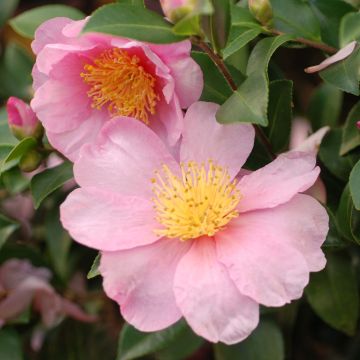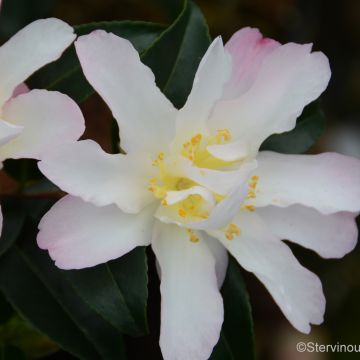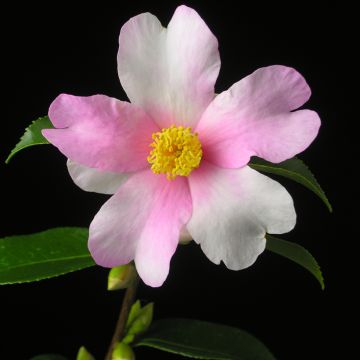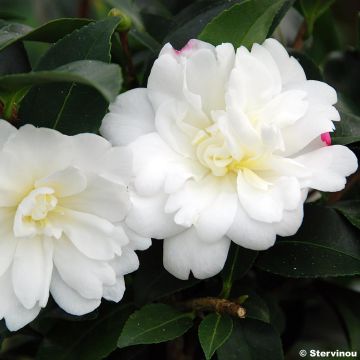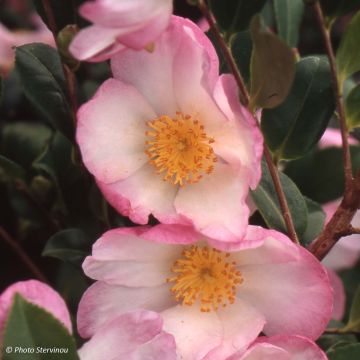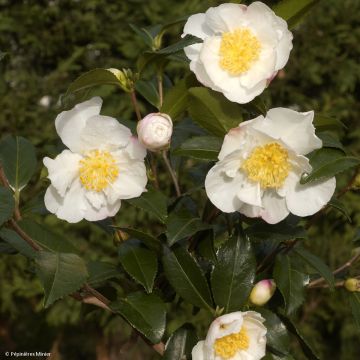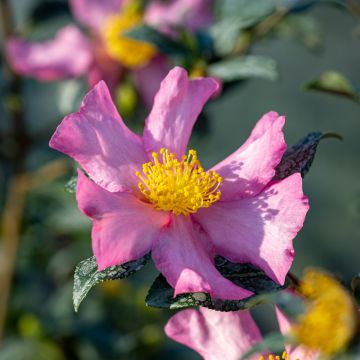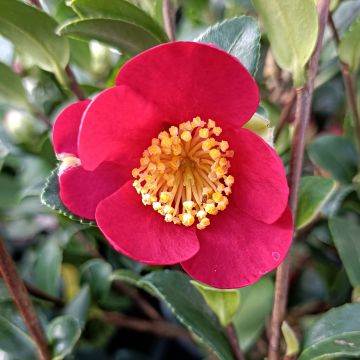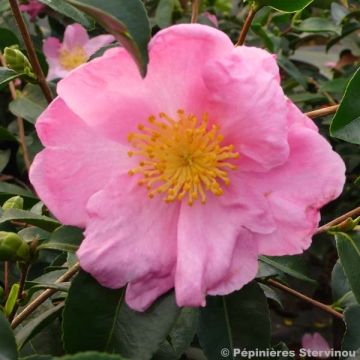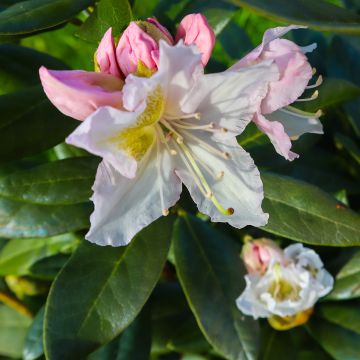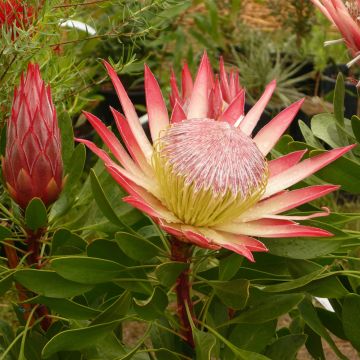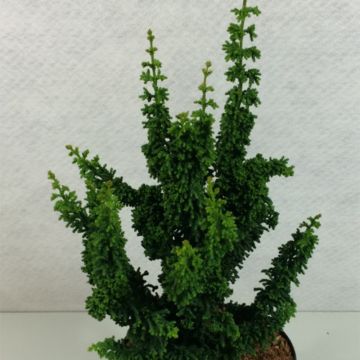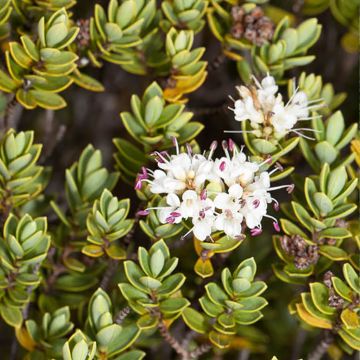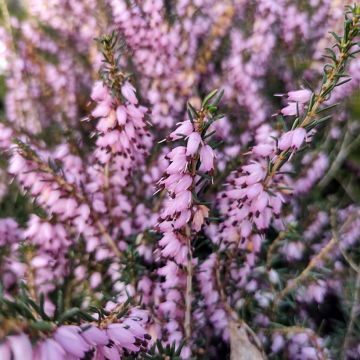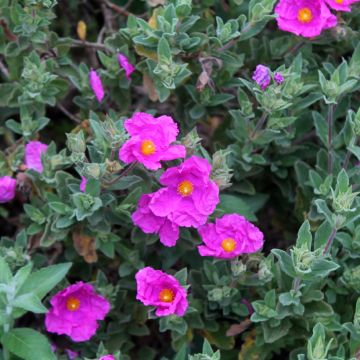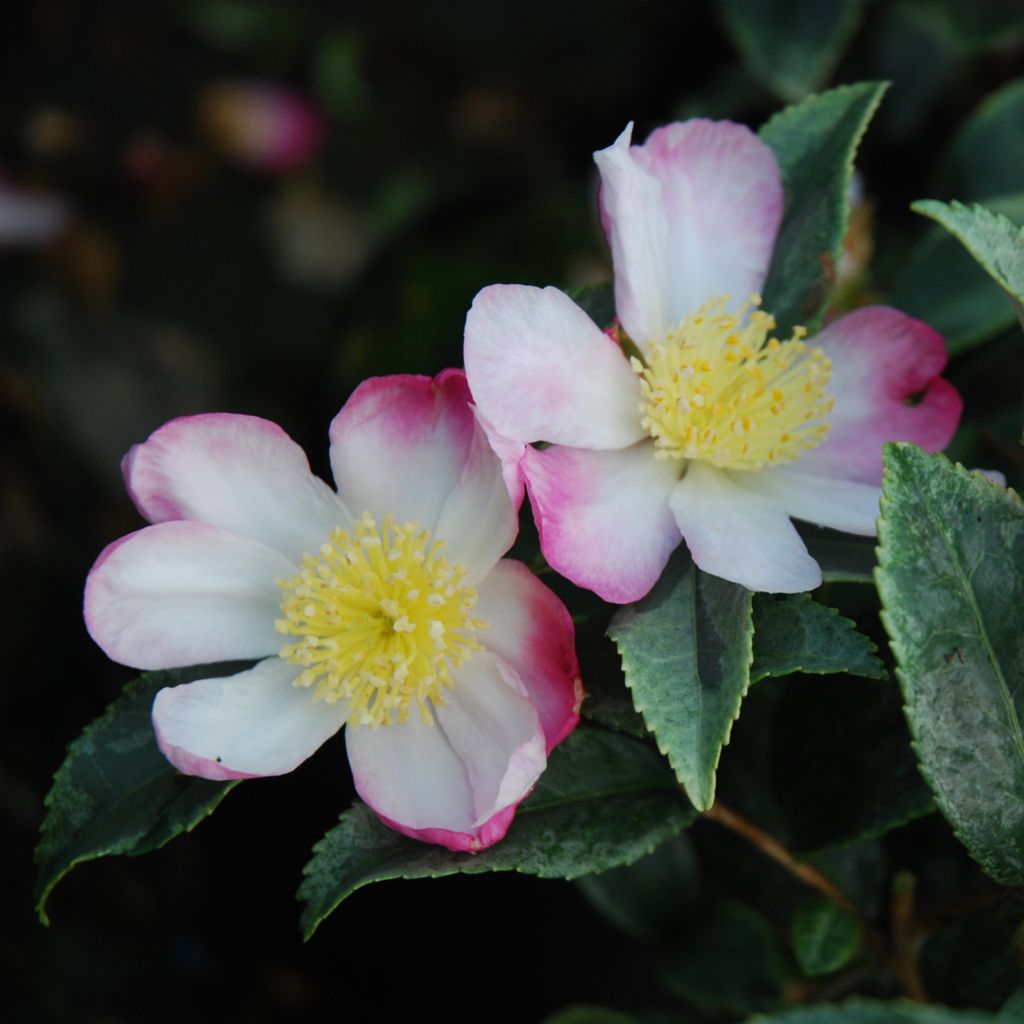

Camélia d'automne panaché - Camelia sasanqua Variegata
Camellia sasanqua Variegata
Camellia sasanqua Variegata
Autumn Camellia, Christmas Camellia
This item cannot be shipped to the selected country
Delivery charge from €5.90
More information
Schedule delivery date,
and select date in basket
This plant carries a 24 months recovery warranty
More information
We guarantee the quality of our plants for a full growing cycle, and will replace at our expense any plant that fails to recover under normal climatic and planting conditions.
From €5.90 for pickup delivery and €6.90 for home delivery
Express home delivery from €8.90.
Does this plant fit my garden?
Set up your Plantfit profile →
Description
Camellia sasanqua 'Variegata', also known as autumn camellia, is a small evergreen bush with a very compact upright habit, distinguished by its foliage that emerges pink in spring and then turns a matte, oddly variegated and marginated green-grey with cream-white. It produces small, fragrant, single anemone-shaped flowers in October-November, with white petals edged and splashed with pink surrounding a large golden stamen centre. It is hardy and able to adapt to windy or sunny conditions, but requires moist soil in summer and is intolerant of limestone. Plant it in pots on a terrace, as a solitary plant in the garden, or in a small flowering hedge.
Hailing from southern Japan, the Camellia sasanqua Versicolor has given rise to numerous cultivars including 'Variegata', which also belongs to the family of tea plants. This camellia forms a compact, particularly upright bush, with a rather slow growth rate, reaching a height of 1 to 1.2 m (3 ft 4 in to 3 ft 11 in) and a width of 80 to 90 cm (2 ft 7 in to 2 ft 11 in) after 10 years. The foliage is remarkable: dense and evergreen, composed of small leaves whose colour evolves from pink in the springtime to variegated green with cream-white in summer. They are ovate and leathery, less coloured on the underside. Its flowering period extends from late September-early October to November, sometimes until February in mild climates. Initially pale pink buds appear, followed by bicoloured flowers measuring 4 to 5 cm (1.6 to 2 in) in diameter, with irregularly pink-edged white petals surrounding a late-revealing golden-yellow stamen centre. The flowers are fragrant and ephemeral, but continuously renew themselves on the plant, leaving a carpet of petals on the ground like cherry trees in Japan.
Camellia sasanqua 'Variegata', just like its Japanese parent, tolerates sun and windy conditions better than other camellias. It performs better in mild climates than in cold regions, where its hardiness is sometimes compromised and its flowering destroyed. Wherever winter is not too harsh, it can be planted in the garden as a standalone specimen or combined with other ericaceous plants (Rhododendron, Azaleas, Hydrangea, Hamamelis) in a flowering hedge. Camellia 'Variegata' deserves a prime position, at the entrance of the garden or along a path. You can also adorn its base with autumn bulbs, such as colchicums or Naples cyclamen. In colder regions, it can be grown on a balcony or terrace and brought indoors during the flowering period to a cool conservatory or unheated greenhouse. Provided its foliage is regularly misted and it is watered with non-chalky water, it can be protected from the cold in a lightly heated apartment.
Report an error about the product description
Camellia sasanqua Variegata in pictures
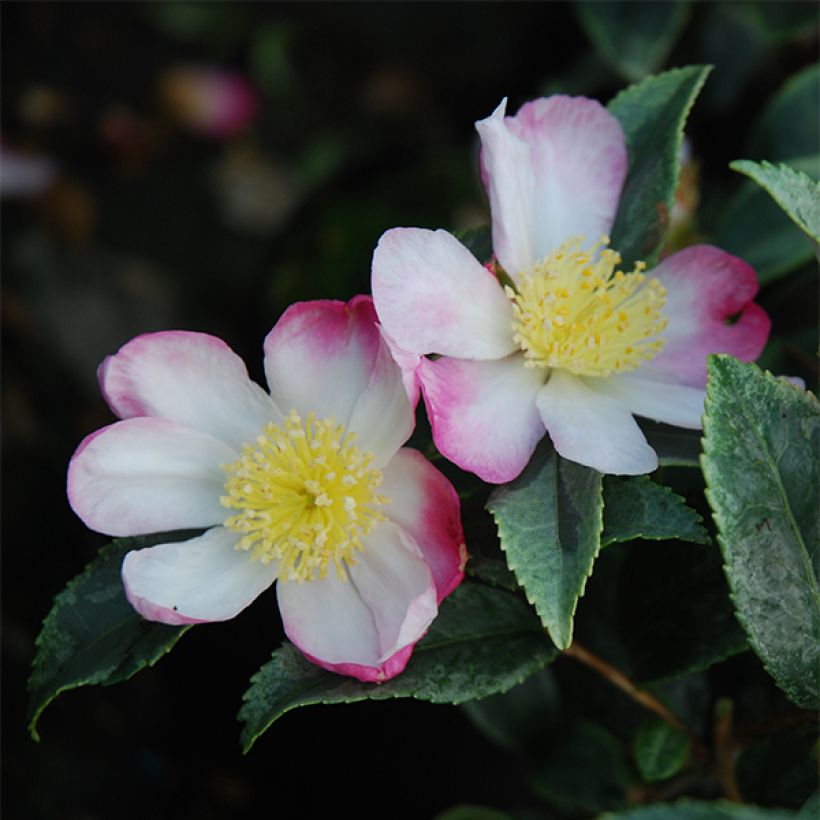

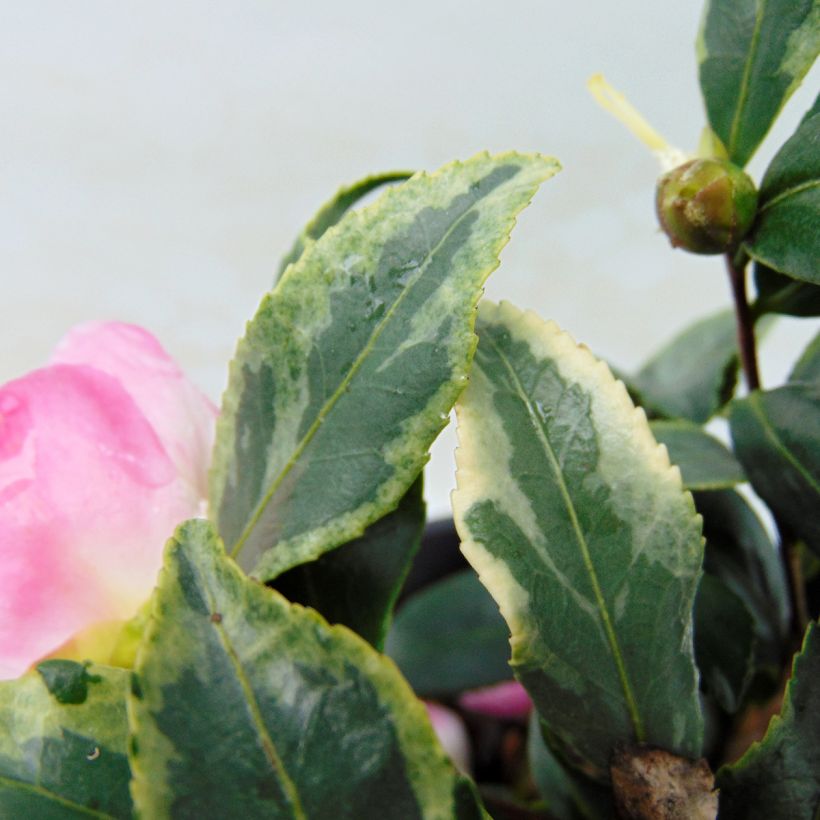

Plant habit
Flowering
Foliage
Botanical data
Camellia
sasanqua
Variegata
Theaceae
Autumn Camellia, Christmas Camellia
Cultivar or hybrid
Other Autumn Camellia
Planting and care
Camellia sasanqua should be placed in a partially shaded site, sheltered from cold and drying winds. Cultivate it in not-too-strong sunlight, but making sure the roots stay moist. Plant it in a deep, moist, humus-rich, acidic, and well-drained soil. Do not plant the bush too deeply; the top of the root ball should be covered with 3 cm (1.2 in) of soil. In winter, cover it with a 5 to 7 cm (2 to 2.8 in) thick mulch composed of leaf compost and crushed bark. Beware of late frosts that can damage the flowers and buds. During dry periods, water the bush to prevent the dropping of flower buds. Pruning should be done every year after flowering. Lightly prune stems that prevent the bush from maintaining its compact habit. Remove faded flowers if you do not want fruits and remove dead shoots. The mature Camellia can withstand heavy pruning. Camellia sasanqua can be susceptible to root rot, leaf spots, and viruses. It can be attacked by aphids and scale insects that cause sooty mould, as well as by weevils.
Planting period
Intended location
Care
-
, onOrder confirmed
Reply from on Promesse de fleurs
Evergreen shrubs
Haven't found what you were looking for?
Hardiness is the lowest winter temperature a plant can endure without suffering serious damage or even dying. However, hardiness is affected by location (a sheltered area, such as a patio), protection (winter cover) and soil type (hardiness is improved by well-drained soil).

Photo Sharing Terms & Conditions
In order to encourage gardeners to interact and share their experiences, Promesse de fleurs offers various media enabling content to be uploaded onto its Site - in particular via the ‘Photo sharing’ module.
The User agrees to refrain from:
- Posting any content that is illegal, prejudicial, insulting, racist, inciteful to hatred, revisionist, contrary to public decency, that infringes on privacy or on the privacy rights of third parties, in particular the publicity rights of persons and goods, intellectual property rights, or the right to privacy.
- Submitting content on behalf of a third party;
- Impersonate the identity of a third party and/or publish any personal information about a third party;
In general, the User undertakes to refrain from any unethical behaviour.
All Content (in particular text, comments, files, images, photos, videos, creative works, etc.), which may be subject to property or intellectual property rights, image or other private rights, shall remain the property of the User, subject to the limited rights granted by the terms of the licence granted by Promesse de fleurs as stated below. Users are at liberty to publish or not to publish such Content on the Site, notably via the ‘Photo Sharing’ facility, and accept that this Content shall be made public and freely accessible, notably on the Internet.
Users further acknowledge, undertake to have ,and guarantee that they hold all necessary rights and permissions to publish such material on the Site, in particular with regard to the legislation in force pertaining to any privacy, property, intellectual property, image, or contractual rights, or rights of any other nature. By publishing such Content on the Site, Users acknowledge accepting full liability as publishers of the Content within the meaning of the law, and grant Promesse de fleurs, free of charge, an inclusive, worldwide licence for the said Content for the entire duration of its publication, including all reproduction, representation, up/downloading, displaying, performing, transmission, and storage rights.
Users also grant permission for their name to be linked to the Content and accept that this link may not always be made available.
By engaging in posting material, Users consent to their Content becoming automatically accessible on the Internet, in particular on other sites and/or blogs and/or web pages of the Promesse de fleurs site, including in particular social pages and the Promesse de fleurs catalogue.
Users may secure the removal of entrusted content free of charge by issuing a simple request via our contact form.
The flowering period indicated on our website applies to countries and regions located in USDA zone 8 (France, the United Kingdom, Ireland, the Netherlands, etc.)
It will vary according to where you live:
- In zones 9 to 10 (Italy, Spain, Greece, etc.), flowering will occur about 2 to 4 weeks earlier.
- In zones 6 to 7 (Germany, Poland, Slovenia, and lower mountainous regions), flowering will be delayed by 2 to 3 weeks.
- In zone 5 (Central Europe, Scandinavia), blooming will be delayed by 3 to 5 weeks.
In temperate climates, pruning of spring-flowering shrubs (forsythia, spireas, etc.) should be done just after flowering.
Pruning of summer-flowering shrubs (Indian Lilac, Perovskia, etc.) can be done in winter or spring.
In cold regions as well as with frost-sensitive plants, avoid pruning too early when severe frosts may still occur.
The planting period indicated on our website applies to countries and regions located in USDA zone 8 (France, United Kingdom, Ireland, Netherlands).
It will vary according to where you live:
- In Mediterranean zones (Marseille, Madrid, Milan, etc.), autumn and winter are the best planting periods.
- In continental zones (Strasbourg, Munich, Vienna, etc.), delay planting by 2 to 3 weeks in spring and bring it forward by 2 to 4 weeks in autumn.
- In mountainous regions (the Alps, Pyrenees, Carpathians, etc.), it is best to plant in late spring (May-June) or late summer (August-September).
The harvesting period indicated on our website applies to countries and regions in USDA zone 8 (France, England, Ireland, the Netherlands).
In colder areas (Scandinavia, Poland, Austria...) fruit and vegetable harvests are likely to be delayed by 3-4 weeks.
In warmer areas (Italy, Spain, Greece, etc.), harvesting will probably take place earlier, depending on weather conditions.
The sowing periods indicated on our website apply to countries and regions within USDA Zone 8 (France, UK, Ireland, Netherlands).
In colder areas (Scandinavia, Poland, Austria...), delay any outdoor sowing by 3-4 weeks, or sow under glass.
In warmer climes (Italy, Spain, Greece, etc.), bring outdoor sowing forward by a few weeks.

































